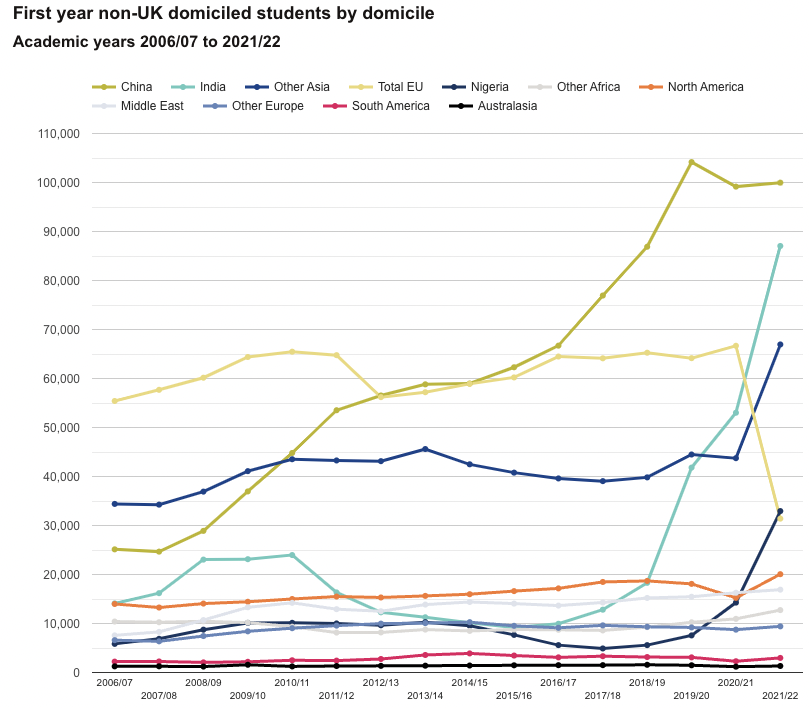Indonesia, Saudi Arabia, Vietnam, Nigeria and India were all named as priority regions in the UK’s 2019 international education strategy as they had “significant potential for growth”.
International education champion Steve Smith’s work focuses on these regions, including attempting to increase education exports, diversify recruitment and address market access barriers.
According to new data from HESA, fewer Vietnamese and Saudi Arabian students were studying in the UK in 21/22 than in the previous academic year.
Smith has facilitated higher education missions to both Indonesia and Saudi Arabia over the past two years. The number of Indonesians increased by 555 students, equivalent to approximately 18% growth.
The data shows a different story for the UK’s other two priority regions, India and Nigeria. The number of Indian students coming to the UK jumped from 84,555 to 126,535, while students from Nigeria more than doubled, reaching 44,195 in 21/22 compared to 21,305 the previous year. The University of Hertfordshire was the top recruiter of both Nigerian and Indian students, enrolling almost 1,000 more Indian students (5,825) than the previous year.
The number of students enrolled in transnational education courses grew in most of the priority regions, as over half a million students globally took transnational courses outside of the UK. The highest numbers of transnational students were based in China, Malaysia and Sri Lanka, making up 31% of all students.
The data also shows that international students make up a growing proportion of postgraduates in the UK. Some 45% of postgraduate students in 21/22 were from outside the UK, increasing from 35% in 17/18. At undergraduate level, 15% were non-UK domiciled.
The number of Chinese students taking postgraduate courses in the UK increased by approximately 5,000 to 88,755, while Indian students at the same level jumped by almost 40,000 to 101,765, outnumbering Chinese students for the first time.
Enrolments from the EU continued to decline following Brexit, with 33,715 postgraduate students in 21/22 from EU countries, down from 43,765 in 2020/21. More first year students came from Nigeria (32,945) than from the whole of the EU (31,400) for the first time. Despite the overall decline, some EU countries showed small growth over the five year period since 2017, including Portugal, Spain, Romania and Poland.
“Last year, the UK had a fairly balanced geographical diversity of the international student population, with only 16 HEIs relying on one country for at least half of their international students,” said Janet Ilieva, director of Education Insight.
“This year’s dip of 67% in the entry of EU students to first-degree programmes will significantly increase the institutional reliance on 1-2 countries.”
This has “huge implications for student diversity in the classroom and highlights the importance of continually monitoring students’ academic experience,” Ilieva said.
Charley Robinson, head of global mobility policy at Universities UK International, said that growth is “complex” but that the government’s policies and diversification work have “reduced the UK’s reliance on a single country”.
Robinson added that the increase in postgraduate students is “very good news” but “in light of the losses from Europe, it’s ever more important that we maintain stable and competitive immigration policies”.
The UK government is reportedly discussing plans to scrap dependant visas for family members of international students, among other connected potential policy changes. Last week, UUKi warned that “blunt bans” have “the potential to adversely affect the UK’s reputation, our economy, and our relationships with key partners such as India and Nigeria”.
The Department for Education has been contacted for comment.

